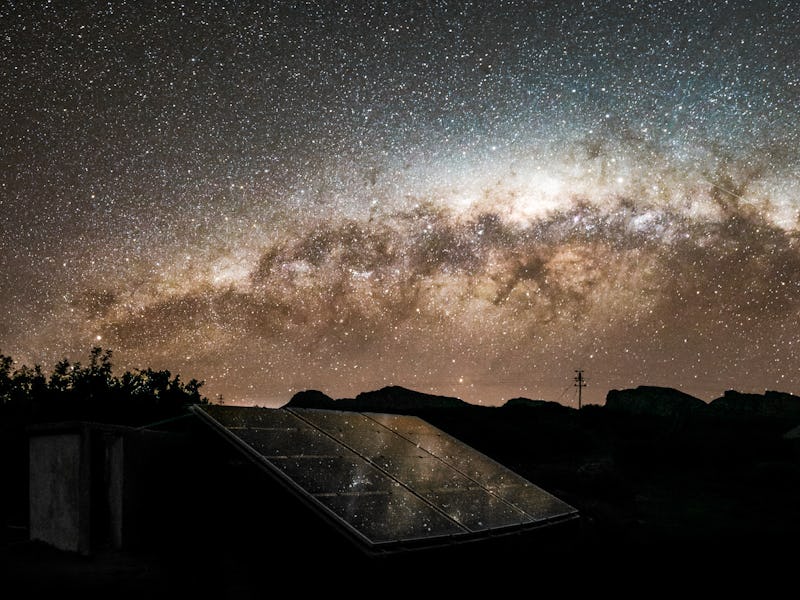Optimized 'anti-solar panels' may be the future of sustainable energy
These energy harvesters can pick up where daytime solar panels leave off.

Solar panels are an incredibly important tool for generating sustainable, clean energy. Their popularity and efficiency are only going up, but there is one problem. They only work half the day.
And in parts of the world with drastic fluctuations in their availability of daylight, such as Nordic countries, these panels can be inefficient not only for large swathes of the day but large parts of the year. As a solution, enter the anti-solar panel.
Not just the traditional solar panel's bad-boy alter ego, anti-solar panels offer a way to harvest energy at night. Together with daytime solar panels, anti-solar panels create a sustainable energy source that can be used all day and all year long.
A new study has determined a way to do this even better.
In a paper published Monday in the journal Optics Express, a team of researchers from Stanford University and the Technion-Israel Institute of Technology explains that their new work focuses on a theoretical optimization of existing infrastructure for anti-solar panels: thermoelectric power generators.
These generators create electric voltage by converting the temperature differences between a heat source (say, the ambient air temperature at night) and a specially cooled surface of the generator.
While these generators do already exist, the study authors argue that they're not living up to their potential and are not sustainable options for off-grid energy generation. Lingling Fan, the study's first author and an electrical engineering Ph.D. candidate at Stanford University, says their study aims to optimize this existing design.
"We are working to develop high-performance, sustainable lighting generation that can provide everyone -- including those in developing and rural areas -- access to reliable and sustainable low-cost lighting energy sources," explains Fan.
Fan says that a modular energy system like this could even be used to convert heat waste from cars into usable power.
What does an anti-solar panel look like?
Despite its linguistic similarity to the common solar panel, anti-solar panels like these don't resemble common roof-topping panels. Instead, they look a little more like a nondescript black box or, internally, as a two-pronged ladder turned on its side.
A thermoelectric generator creates energy using the temperature difference from the surrounding air and radiant cooling from space.
On top of this system is what's called the "cool side," which faces up towards the cooler night air. On the bottom side is the "hot side," which the researchers generalize as being an ambient temperature of 80 degrees Fahrenheit. The combination of these two sides of the generator helps it avoid heat dissipation and enables effective energy harvesting.
With this basic model in mind, the team experimented with simulating different improvements, such as improving how heat flows through the system and using commercially available thermoelectric materials to improve how efficiently the system uses its energy.
Wei Li, a co-author of the study and postdoctoral fellow at Stanford, says that one of the most important changes they simulated was using a material to better control how the generator dumped excess heat.
"One of the most important innovations was designing a selective emitter that is attached to the cool side of the device," Li says. "This optimizes the radiative cooling process so that the power generator can more efficiently get rid of excessive heat."
After analyzing these simulated upgrades, the team found that their design was capable of generating 2.2 Watts of energy per square meter, which is 120 times more energy than previous experimental models have been able to achieve, write the authors.
The authors also that a system like this could even be used during the day, creating an overlap of energy production with traditional solar panels.
What's next — That said, there is a difference between simulated results and how this system might perform in the wild.
Nonetheless, the authors argue that this design demonstrates that such a system is theoretically achievable using commercially available technology — we don't have to wait for new materials or innovations. In the future, this off-the-grid solution could be used to supply sustainable energy and power essential services.
Abstract: We present a systematic optimization of nighttime thermoelectric power generation system utilizing radiative cooling. We show that an electrical power density >2 W/m2, two orders of magnitude higher than the previously reported experimental result, is achievable using existing technologies. This system combines radiative cooling and thermoelectric power generation and operates at night when solar energy harvesting is unavailable. The thermoelectric power generator (TEG) itself covers less than 1 percent of the system footprint area when achieving this optimal power generation, showing economic feasibility. We study the influence of emissivity spectra, thermal convection, thermoelectric figure of merit and the area ratio between the TEG and the radiative cooler on the power generation performance. We optimize the thermal radiation emitter attached to the cold side and propose practical material implementation. The importance of the optimal emitter is elucidated by the gain of 153% in power density compared to regular blackbody emitters.